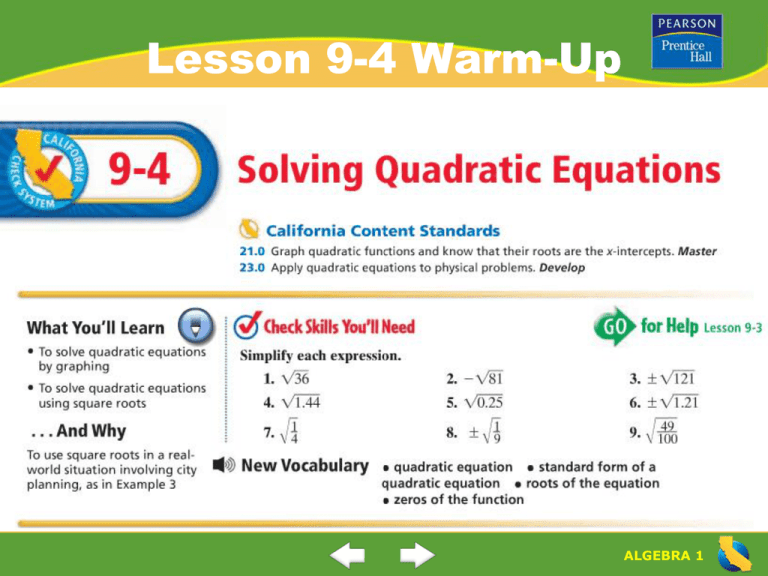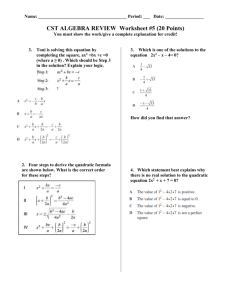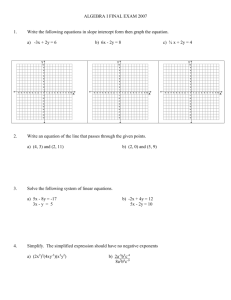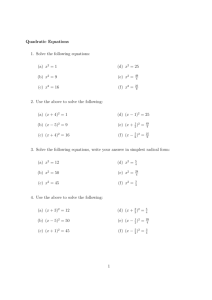Solving Quadratic Equations
advertisement

Lesson 9-4 Warm-Up ALGEBRA 1 “Solving Quadratic Equations” (9-4) What is a quadratic equation? quadratic equation: a quadratic function (y = ax2 + bx + c) where y = 0 and written in the standard form: ax2 + bx + c = 0 Tip: Recall that to find the x-intercepts of a quadratic function, find x when y = 0. Therefore, the solution(s) of a quadratic equation are also the x-intercepts of the graph of the quadratic function (which is a parabola). What are the “roots of the equation” or the “zeros of the function”? Since a parabola can have two, one, or no points that cross the x-axis (xintercepts), a quadratic equation can have two, one, or no solutions. The solutions of a quadratic equation and the related x-intercepts are called the roots of the equation or the zeros of the function. ALGEBRA 1 “Solving Quadratic Equations” (9-4) To solve a quadratic equation, substitute 0 for y and solve for x. How do you solve a quadratic Example: y = x2 - 4 equation when b x2 - 4 = 0 Make y = 0 and write it in standard form (zero on = 0? right side of equal sign) + 4 4 x2 =4 x2 = 4 x = 2 Add 4 to both sides Simplify Find the square root of each side to eliminate the square (square root of a square is the number – the operations cancel each other out) The square root of a number can be negative (-•=+) The solutions, or x-intercepts, of y = x2 - 4 are 2 and -2. ALGEBRA 1 Solving Quadratic Equations LESSON 9-4 Additional Examples Solve each equation by graphing the related function. a. 2x2 = 0 Graph y = 2x2 There is one solution, x = 0. b. 2x2 + 2 = 0 Graph y = 2x2 + 2 There is no solution. c. 2x2 – 2 = 0 Graph y = 2x2 – 2 There are two solutions, x = ±1. ALGEBRA 1 Solving Quadratic Equations LESSON 9-4 Additional Examples Solve 3x2 – 75 = 0. 3x2 – 75 + 75 = 0 + 75 Add 75 to each side. 3x2 = 75 x2 = 25 x2 = x=±5 Divide each side by 3. 25 Square root both sides to isolate the x. Simplify. ALGEBRA 1 “Solving Quadratic Equations” (9-4) How can you solve a real world problem involving square roots? To solve a real-world problem or equation involving square roots, negative solutions are not reasonable and thus should be eliminated (not used). ALGEBRA 1 Solving Quadratic Equations LESSON 9-4 Additional Examples A museum is planning an exhibit that will contain a large globe. The surface area of the globe will be 315 ft2. Find the radius of the sphere producing this surface area. Use the equation S = 4 r2, where S is the surface area and r is the radius. S = 4 r2 315 = 4 r 2 4 4 Substitute 315 for S. 315 = r2 4 Divide each side by p (4). 315 =r (4) Square root each side to isolate the r. 5.00668588 r Use a calculator. Since a negative solution isn’t reasonable (doesn’t make sense), only the positive solution should be used. The radius of the sphere is about 5 ft. ALGEBRA 1 Solving Quadratic Equations LESSON 9-4 Lesson Quiz 1. Solve each equation by graphing the related function. If the equation has no solution, write no solution. a. 2x2 – 8 = 0 ±2 b. x2 + 2 = –2 no solution 2. Solve each equation by finding square roots. a. m2 – 25 = 0 ±5 b. 49q2 = 9 3 ±7 3. Find the speed of a 4-kg bowling ball with a kinetic energy of 160 joules. Use the equation E = 1 ms2, where m is the object’s mass in kg, 2 E is its kinetic energy, and s is the speed in meters per second. about 8.94 m/s ALGEBRA 1








